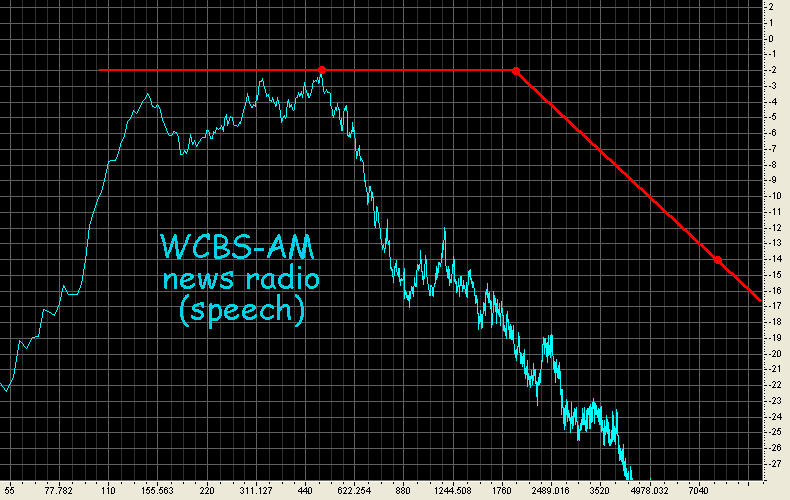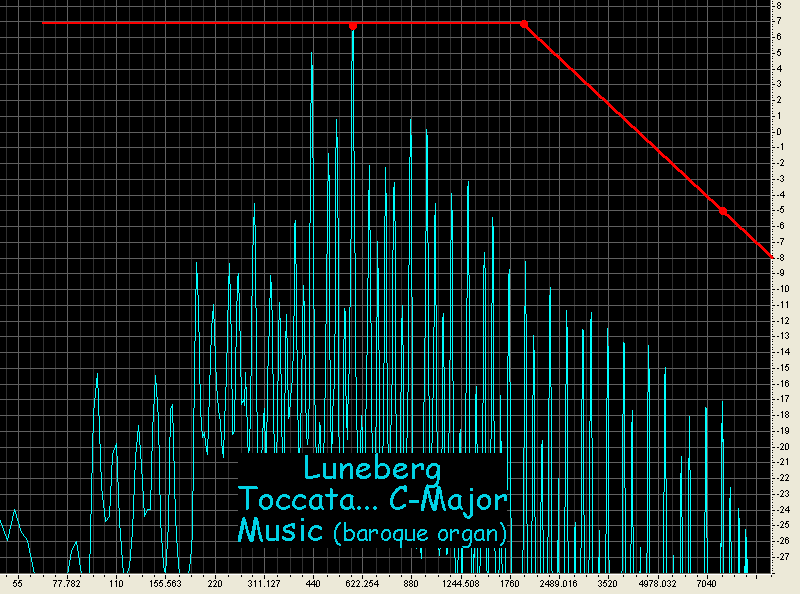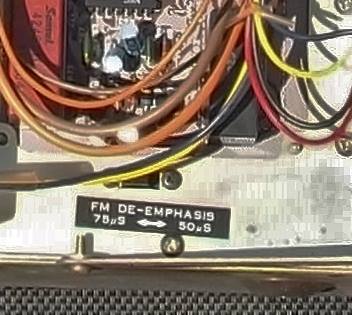FM Pre-Emphasis and De-Emphasis
FM Pre-Emphasis and De-Emphasis

FM systems use a pre-emphasis for the audio signals. That means, all audio frequencies above a corner frequency are emphasized.
The corner frequencies are:
- fc = 2.1221 kHz for region 2 (the Americas)
- fc = 3.1831 kHz for Region 1 (Europe and Asia)
This gives the time constants:
- τ = 75 μsec for region 2
- τ = 50 μsec for region 1
In the beginning of the FM area even a time constant τ = 100 μsec was tested.

Pre-emphasis with 100 μsec gives a too much treble boost, and the transmitter may be overdriven.
At the receiver's side a corresponding De-emphasis has to be applied in order to get a flat frequency response for the transmitter - receiver chain.

In this diagram also the reason for the pre-emphasis / de-emphasis can be seen. With frequency modulation the higher audio frequencies suffer more and more from noise (hiss). To alleviate this the pre-emphasis is applied at the TX, and the de-emphasis is applied at the RX. Together with the compensation for higher audio frequencies also the hiss is reduced by de-emphasis.
Radio collectors sometimes have a problem with the different values of time constants. Often collectors in US have European sets in their collection, and European collectors may have some US sets. What is the consequence of the different time constants or corner frequencies?
 The Matlab graph shows what happens:
The Matlab graph shows what happens:
- red: an European set receives an US transmitter: trebble boost of approx. 3.5 dB
- blue: an US set receives an European transmitter: bass boost of approx. 3.5 dB
However, this can be settled by the tone control of the receiver, and so no change of the receiver's time constant is really necessary. It is only to be recognized that the neutral position of the tone control knobs are different now.
Furthermore today very many broadcasters use a dynamic form of pre-emphasis and some other sophisticated tone processing, done by an Optimod® processor. That is why the correct value of the de-emphasis time constant plays no major role any more.
Regards,
Dietmar
To thank the Author because you find the post helpful or well done.
Pre-Emphasis and De-Emphasis Bode Diagrams

The Pre-Emphasis and De-Emphasis Bode Diagrams shown in post#1 may be simplified for the sake of easier understanding of the effect due to the different corner frequencies used in US and in Europe/Asia.To this end, the Bode diagrams are approximated by straight lines.
- Pre-Emphasis gives a horizontal line up to its corner frequency fc_Pre and then ascending by a slope of + 20 dB/Decade.
- De-Emphasis also gives a horizontal line up to its corner frequency fc-De and afterwards a descenting line with a slope of - 20 dB/Decade.
- Because logarithmically multipication changes to addition, these lines can be added and provide the resultant amplitude.

Because 20 dB is a factor of 10 in amplitude, and also 1 Decade is a factor of 10 in frequency, +20 dB/Decade means that amplitude is direct proportional to frequency, the resultant amplitude due to the mismatch of the corner frequencies gives 20*log10(3/2) = 20*log10(75/50) ≈ 3.5 dB.
For practical cases, these results only apply for HIFI sets without any twisted tone control, and which have an absolut linear frequency range. Therefore, for most sets they are no longer relevant today.
In former days, when the transmitters still had a linear frequency range (excluded pre-emphasis), a sonorous bass volume of the receiver called for a big bass boost in the receiver. And most tube receivers do have that, and so have the typical "wooden tube radio sound".
Nowadays broadcasters use sopisticated audio processing (mostly Optimode), thereby boostig bass and treble. Furthermore, the dynamic of the sound signal is greatly reduced (sometimes to 3 dB). These stations sound very loud (or strong?) what is benefical for mobile car reception and advertizing.

Together with Optimod bass boost at the transmitter's side and the bass boost incorporated in an vintage tube FM set, a thump sound will occur. However, this is not a problem of the mismatch of the Pre-emphasis and De-emphasis time constants.
Regards,
Dietmar
To thank the Author because you find the post helpful or well done.
Separating time costants mismatch and audio processing

FM tube radios from Europe were designed at times when FM transmitters did not use audio processing (compressing, bass and treble boost) in such amount like today where extensive Optimod sound processing is usual.
European tube sets often have a built in treble and bass boost possibiliy, sometimes called "Wunschklang-Register". However, boosting in the receiver like in those sets and additionally boosting at the transmitter as it is usual today may bee to much, and no good sound quality will result any more.
Nowadays small FM transmitters are available for few $ cost, and they don't have audio processing.


left: some examples of FM TXs; right: FM TX from ELV, whos spectra are shown in RM.
With such a small FM TX a FM signal like in former radio days can be provided. In this way a separation of the influence of pre-emphase time constant and audio processing will be possible.
Regards,
Dietmar
To thank the Author because you find the post helpful or well done.
Why we can pre-emphasize
> ...the reason for the pre-emphasis / de-emphasis can be seen. ... the hiss is reduced by de-emphasis.
Yes, but there is another factor.
We "can" boost the highs before the transmitter because in speech or music the high frequency sounds are weak compared to the mid and bass sounds.
I've known this for years, from books and observations. However your essay inspired me to re-check the idea with familiar sounds.
I ran spectrum analysis on several recordings of sounds we might hear on radio.
For speech I used a news-radio broadcast, WCBS-AM news-brief. (Yes, this is AM but speech is not very different AM or FM; also I used WCBS's internet signal.)

There is a wide choice of popular music. The general spectrum does not vary a lot. I used ABBA's 'Dancing Queen' because it may be familiar to many and because it was handy.

'Classical' or 'good' music can vary a lot. And analysis of a full symphony takes a long time. I used a sample of baroque organ (*), which happened to have little bass content. Some heavy organ works on boomy 20th century organs will fill-up the bass, though not as much as ABBA.

After capturing the spectra, I plotted a line across the tallest frequency peaks, breaking at 2KHz (US de-emphasis) to 6db/octave.
As you can see, if the stronger sounds below 2KHz are not over-modulating the channel, then sounds above 2KHz will not over-modulate even if boosted 6db/octave above 2KHz.
So why not 1KHz or 3KHz?
For speech and many selections of older music, a 1KHz corner would work fine. And it would give significantly less channel hiss.
However if you look at the ABBA sample and discount the artificial boom at 55Hz, then shift the red line to fit, both the 440Hz peak and the 2600Hz peak would touch the line. The US 2KHz pre-emphasis just barely clears ABBA. There are many less-common musical styles, even before elaborate studio tricks, which if pre-emphasized too soon may over-modulate in the highs before the bass or middle.
Most music will pass 1KHz boost fine, but some tracks will distort. Far fewer tracks will distort with a 2KHz boost, enough so the 6db higher hiss is justified. A small number of tracks will distort for 2KHz, not for 3KHz. To pass these cleanly you must accept 3db more hiss.
I do not know why the US picked 2KHz and Europe picked 3KHz. It may be because the long distances in the US mean more fringe listeners who have increased hiss levels due to weak signals. There are also economic influences: US stations needed large audiences for advertising income and favored "light" music over long telephone lines; in Europe much radio was operated by national organizations, and pressure for listenership was instead a sense of pride in quality signals.
(*) St. Johannis Church in Luneberg, Germany
Bach's Toccata, Adagio and Fugue in C-Major
M. Schneider
To thank the Author because you find the post helpful or well done.
Correction
Correction:
> 1KHz boost ... 2KHz boost, .. 6db higher hiss
> 2KHz, ...3KHz. ... 3db more hiss.
Should read:
1KHz boost ... 2KHz boost, ... 3 db higher hiss
2KHz, ...3KHz. ... 1.5 db more hiss.
To thank the Author because you find the post helpful or well done.
De Emphasis Switch

Omer Suleimanagich wrote in a mail:
Apropos I have sent you a pic from a Sansui receiver from the 60’s that has an adjustment switch in the back for FM broadcast standards of the region. This is pertaining to a discussion about Grundig receivers manufactured in the fifties and sixties , that had one FM circuit that was used for Europe and North America radio reception. Telefunken at the time , was the only German manufacturer that paid for the use of the Armstrong license, and they manufactured radios with FM circuits specific to their region of sale.

Your explanation on the thread was, from what I understood, it is not important for audio reproduction from the FM signal for a need to have two different FM circuits.
Because nobody knows how the original sound of a received was, a wrong time constant may be "compensated" by adjustment of treble and bass controls.
Regards, Dietmar
To thank the Author because you find the post helpful or well done.
De Emphasis Switch
> not important for audio reproduction from the FM signal for a need to have two different FM circuits.
As you say, the difference between European and American technical standards is small, and may be nearly compensated with a Treble control. The difference on the transmitter side is completly un-important to receiver owners, except we "should" use the same de-emphasis (perhaps using Treb knob shift) as the transmitter to recover the signal exactly as intended.
It is very true that in radio we never get the recording (or live broadcast) "verbatim". "ALL" commercial broadcasters have "tone controls" which are highly automated (continuously boosting or cutting narrow frequency bands) for maximum "impact". You are not hearing what Shane or Abba put on the record, but how the Station Director wants the station to sound. "Like" the record, but LOUDER, to catch more ears and charge more for commercials.
If we really want to know the "sound" that the Station Director is putting on the air, we "should" use the same de-emphasis as the station. (However the ear is adaptable and if I bring a US radio to Europe unmodified, I can compare stations one to another and my ear will learn to discount the fact that all are "weak highs" on my US radio.)
And as you say, very few few listening situations have "an absolute linear frequency range". In setting-up such a system, de-emphasis would be part of the process.
I happened to have my simulator handy and re-ran the equalization curves, just confirming the curves you posted above. A US radio in Europe will be -2dB @ 3KHz. This is very small, and a Treb knob could get it to 1dB total error pre_de_emphasis.gif
> "an adjustment switch in the back for FM broadcast standards of the region"
This may be trivial. I attach a possible 75/50uS switch plan. One capacitor and one switch. (Stereo is usually de-emph-ed after decoding, so two caps and a DPST switch.) I suspect this was rarely done between Europe and America-- radios and tuners were fitted for the place they were sold. The Japanese on the other hand hoped for global sales, even places where they did not know what EQ to supply, so a switch for de-emph and a switch for wall-voltage let them build one model and sell it anywhere.

I do agree that this is almost never necessary, and certainly not to "just enjoy" a vintage radio.
To thank the Author because you find the post helpful or well done.
Optimod & Loudness wars
Because of badly configured Optimod and "loudness" wars you can now get better FM quality from a €6 FM CE approved transmitter intended to connect MP3 player or phone to the car radio. I use CDs ripped to 256K and 320K MP3 and also 3 x satellite receivers to feed my three home legal FM channels.
Indeed the reciever de-emphasis has nearly become irrelevant. Also good luck buying a retail local shop AM/FM radio (some car radios are still good) that is better than a 1960s pocket AM only set from Hong Kong. Some €150 "big label" models are now just brands owned by international importers using similar Chinese insides to a €15 model.
So I have some early 1960s valve sets and some transistor sets from 1965 to 1986 as "decent" AM/FM sets.
I use a 3.3V zener and resistor to power the FM gadget from the satellite receiver 5V or laptop USB. I found one €4 FM transmitter that was very distorted on battery (a single AAA cell) and fine on the coax power jack. The ICs in these work from 2.75V to 3.5V. Some kave a LDO 3.3V regulator for external power in. Obviously they work badly with a single AA cell.
Some National stations and local FM have quite appalling quality, some using 128K MP2 feed for the FM TX (from satellite). The same MP2 feed seems to be used for DVB-T and DAB. I only use that station for news twice a day.
The other problem is the same optimod settings used for FM loudness wars feeding the Digital signals. FM pre-emphasis, never mind agressive optimod is incompatible with Digital.
One local FM station seems quite good. But basically I wonder are station Engineers allowed to do their job any longer? Or are they properly trained. Some of the UK national stations seriously lack in quality as well as Irish ones. Well, with an old PC / laptop, free Linux and €6 of CE certified FM transmitter you can set your own pre-emphasis and have better technical quality now than most radio stations!
Make sure to set the audio level for correct deviation. I think some of the CE marked transmitters actually have US pre-emphasis.
I've experimented with adding RDS, but only my car radio (parked in driveway) has a decoder apart from my two DAB/FM sets which only have 3" speakers driven by earphone ampliers in mono-bridge!
To thank the Author because you find the post helpful or well done.
Optimod & Loudness wars

Is this one of the units that you have issues with?
8600
OPTIMOD-FM/HD 8600
From: OrbanFeatures:
-Universal transmitter protection & audio processing for FM broadcast
-Pre-emphasis limiting
-Tight peak control at all its outputs
-Stereo encoder integrated with audio processing
Features:
-Frequency Response(Bypass Mode; Analog Processing Chain): Follows standard 50μs or 75μs pre-emphasis curve ±0.10 dB, 2.0 Hz - 15 kHz. Analog left/right output and Digital output can be user configured for flat or pre-emphasized output.
-Samplerate:64 kHz to 512 kHz, depending on processing being performed.
-Noise:Output noise floor will depend upon how much gain the processor is set for (Limit Drive, AGC Drive, Two-Band Drive, and/or Multiband Drive), gating level, equalization, noise reduction, etc. It is primarily governed by the dynamic range of the A/D converter, which has a specified overload-to–noise ratio of 110 dB. The dynamic range of the digital signal processing is 144 dB.
-Total System Distortion (de-emphasized, 100% modulation):<0.01% THD, 20 Hz - 1 kHz, rising to <0.05% at 15 kHz. <0.02% SMPTE IM Distortion.
-Total System Separation:> 55 dB, 20 Hz - 15 kHz; 60 dB typical.
-Polarity (Two-Band and Bypass Modes): (Two-Band and Bypass Modes): Absolute polarity maintained. Positive-going signal on input will result in positive-going signal on output when HD Polarity and FM polarity controls are set to POSITIVE.
To thank the Author because you find the post helpful or well done.
Optimod & Loudness wars
The issue is with how people use them. Not the technology itself.
To thank the Author because you find the post helpful or well done.
Optimod & Loudness wars

There is nothing wrong with analyzing the discriminator, and adjusting the it for 50 us or 75 us
Many of the German table radios and consoles that we have restored here, had their discriminator circuits adjusted for the North American 75 us standard
It is amazing to see ALL the beautiful and ingenious mid 20’Th century engineering put to light when the FM section is working at it’s best, per geographical region where it is being operated!
The reason many of the German radios from 50-60 years ago did not show any issues earlier, FM broadcasting back then, was tame enough to be adjusted to Professor Dietmar Rudolph's explanation of only adjusting the treble and bass for proper sound reproduction
Many collectors used to recone their speakers in an attempt to listen to rock and jazz music, believing that the speakers had issues, and to their dismay still had the same problems
When we began to adjust the discriminators on non Telefunken receivers, the distortion was eliminated
To thank the Author because you find the post helpful or well done.